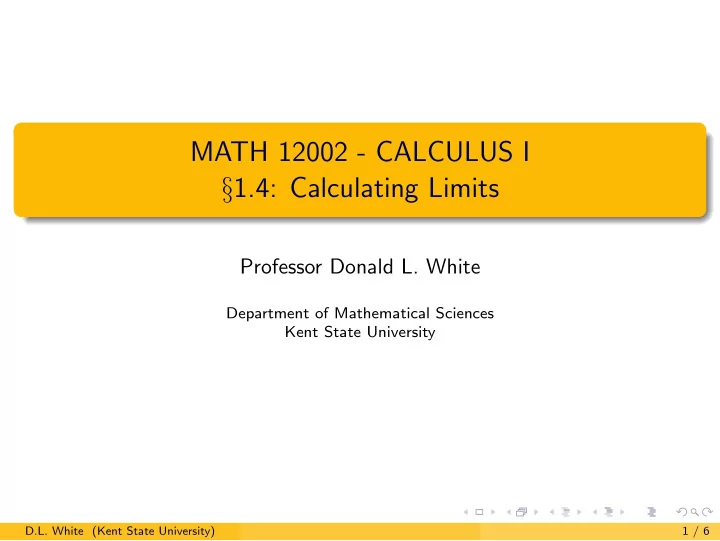

MATH 12002 - CALCULUS I § 1.4: Calculating Limits Professor Donald L. White Department of Mathematical Sciences Kent State University D.L. White (Kent State University) 1 / 6
Cancellation One of our Limit Laws states that if f ( x ) and g ( x ) are functions such that x → a f ( x ) and lim lim x → a g ( x ) both exist, and lim x → a g ( x ) � = 0, then x → a f ( x ) lim f ( x ) lim g ( x ) = x → a g ( x ) . lim x → a But what if lim x → a g ( x ) = 0? We will consider the situation where x → a g ( x ) = 0 and lim lim x → a f ( x ) � = 0 in § 1.6. For now, we will consider the situation where both x → a g ( x ) = 0 and lim lim x → a f ( x ) = 0 . D.L. White (Kent State University) 2 / 6
Cancellation If f ( x ) and g ( x ) happen to be polynomials and lim x → a g ( x ) = 0 and x → a f ( x ) = 0, then f ( x ) and g ( x ) will have the common factor x − a , lim which we will be able to “cancel” in order to obtain a limit we may be able to compute. Recall our example from § 1.3: Example x 2 − 4 Find lim x − 2 . We have x → 2 x 2 − 4 ( x − 2)( x + 2) lim = lim x − 2 x − 2 x → 2 x → 2 = x → 2 ( x + 2) lim = 2 + 2 = 4 . But why are we allowed to “cancel” the x − 2 factors in this equation? D.L. White (Kent State University) 3 / 6
Cancellation In general, if r � = 0, then r r = 1, and so if s and t � = 0 are numbers, then rs rt = r r · s t = 1 · s t = s t . If r = 0, this equation is not valid, however. In particular, if f ( x ) = x 2 − 4 x − 2 = ( x − 2)( x + 2) and g ( x ) = x + 2 , x − 2 then f (2) is undefined, while g (2) = 4. Therefore, as functions of x , f ( x ) � = g ( x ). They are not the same function! So why are lim x → 2 f ( x ) and lim x → 2 g ( x ) equal? D.L. White (Kent State University) 4 / 6
Cancellation Their graphs may give us a clue: � � � � � � ❜ r � � � � � � � � � � � � � � f ( x ) = x 2 − 4 g ( x ) = x + 2 x − 2 Notice that the only point where the functions differ is at x = 2. D.L. White (Kent State University) 5 / 6
Cancellation Let’s look at this situation algebraically. For all x � = 2 we have x − 2 � = 0, and so x − 2 x − 2 = 1. Hence, as before, for x � = 2 , we have f ( x ) = ( x − 2)( x + 2) = x − 2 x − 2 · ( x + 2) = 1 · ( x + 2) = ( x + 2) = g ( x ) . x − 2 So for all x except x = 2, we have f ( x ) = g ( x ). Now recall our definition of limit : Definition Let y = f ( x ) be a function and let a and L be numbers. We say that the limit of f as x approaches a is L if y can be made arbitrarily close to L by taking x close enough to a , but not equal to a . What happens at x = a is not relevant! Therefore, since f ( x ) = g ( x ) for all x � = 2 and x = 2 is not considered when computing the limit as x → 2, we have lim x → 2 f ( x ) = lim x → 2 g ( x ). D.L. White (Kent State University) 6 / 6
Recommend
More recommend